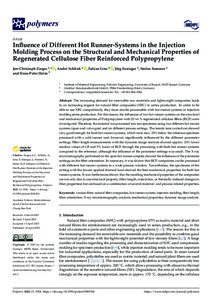| dc.date.accessioned | 2023-07-27T12:09:22Z | |
| dc.date.available | 2023-07-27T12:09:22Z | |
| dc.date.issued | 2023-04-18 | |
| dc.identifier | doi:10.17170/kobra-202307278508 | |
| dc.identifier.uri | http://hdl.handle.net/123456789/14939 | |
| dc.description.sponsorship | Gefördert durch den Publikationsfonds der Universität Kassel | |
| dc.language.iso | eng | |
| dc.rights | Namensnennung 4.0 International | * |
| dc.rights.uri | http://creativecommons.org/licenses/by/4.0/ | * |
| dc.subject | viscose fiber | eng |
| dc.subject | natural fiber composites | eng |
| dc.subject | hot runner system | eng |
| dc.subject | injection molding | eng |
| dc.subject | fiber length | eng |
| dc.subject | fiber orientation | eng |
| dc.subject | X-ray microtomography analysis | e |
| dc.subject | mechanical properties | eng |
| dc.subject | dynamic image analysis | eng |
| dc.subject.ddc | 600 | |
| dc.title | Influence of Different Hot Runner-Systems in the Injection Molding Process on the Structural and Mechanical Properties of Regenerated Cellulose Fiber Reinforced Polypropylene | eng |
| dc.type | Aufsatz | |
| dcterms.abstract | The increasing demand for renewable raw materials and lightweight composites leads to an increasing request for natural fiber composites (NFC) in series production. In order to be able to use NFC competitively, they must also be processable with hot runner systems in injection molding series production. For this reason, the influences of two hot runner systems on the structural and mechanical properties of Polypropylene with 20 wt.% regenerated cellulose fibers (RCF) were investigated. Therefore, the material was processed into test specimens using two different hot runner systems (open and valve gate) and six different process settings. The tensile tests carried out showed very good strength for both hot runner systems, which were max. 20% below the reference specimen processed with a cold runner and, however, significantly influenced by the different parameter settings. Fiber length measurements with the dynamic image analysis showed approx. 20% lower median values of GF and 5% lower of RCF through the processing with both hot runner systems compared to the reference, although the influence of the parameter settings was small. The X-ray microtomography performed on the open hot runner samples showed the influences of the parameter settings on the fiber orientation. In summary, it was shown that RCF composites can be processed with different hot runner systems in a wide process window. Nevertheless, the specimens of the setting with the lowest applied thermal load showed the best mechanical properties for both hot runner systems. It was furthermore shown that the resulting mechanical properties of the composites are not only due to one structural property (fiber length, orientation, or thermally induced changes in fiber properties) but are based on a combination of several material- and process-related properties. | eng |
| dcterms.accessRights | open access | |
| dcterms.creator | Zarges, Jan-Christoph | |
| dcterms.creator | Schlink, André | |
| dcterms.creator | Lins, Fabian | |
| dcterms.creator | Essinger, Jörg | |
| dcterms.creator | Sommer, Stefan | |
| dcterms.creator | Heim, Hans-Peter | |
| dcterms.extent | 19 Seiten | |
| dc.relation.doi | doi:10.3390/polym15081924 | |
| dc.subject.swd | Viskose | ger |
| dc.subject.swd | Verbundwerkstoff | ger |
| dc.subject.swd | Bildanalyse | ger |
| dc.subject.swd | Mechanische Eigenschaft | ger |
| dc.type.version | publishedVersion | |
| dcterms.source.identifier | eissn:2073-4360 | |
| dcterms.source.issue | Issue 8 | |
| dcterms.source.journal | Polymers | eng |
| dcterms.source.volume | Volume 15 | |
| kup.iskup | false | |
| dcterms.source.articlenumber | 1924 | |



